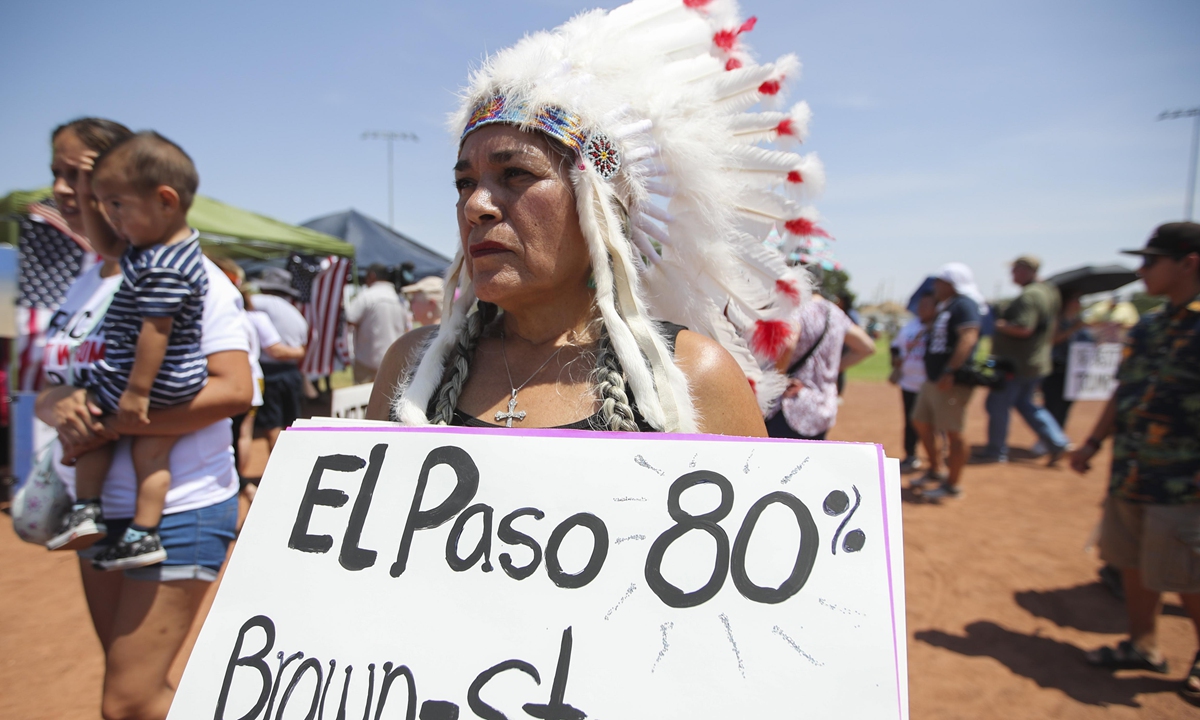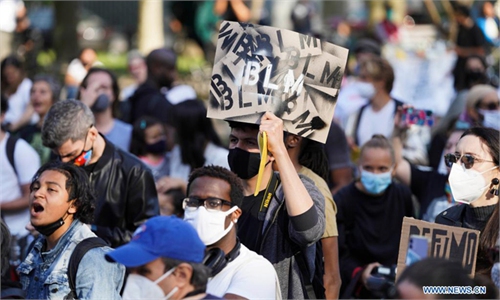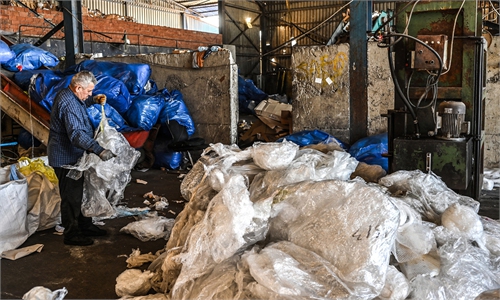IN-DEPTH / IN-DEPTH
US’ systemic genocide against American Indians shouldn’t be forgotten as US tries to smear China with Xinjiang allegations
Bloody history

American Indians attend an anti-racism rally in El Paso, Texas, the US on August 7, 2019. Photo: Xinhua
On December 9, 1948, the UN General Assembly adopted Resolution 260A, or the Convention on the Prevention and Punishment of the Crime of Genocide, which was enacted on January 12, 1951. The resolution noted that "at all periods of history genocide has inflicted great losses on humanity." Article II of the convention clearly defines genocide as any of the following acts committed with intent to destroy, in whole or in part, a national, ethnical, racial, or religious group, as such: (a) Killing members of the group; (b) Causing serious bodily or mental harm to members of the group; (c) Deliberately inflicting on the group conditions of life calculated to bring about its physical destruction in whole or in part; (d) Imposing measures intended to prevent births within the group; (e) Forcibly transferring children of the groups to another group.The United States ratified the convention in 1988.
Since its colonial period, the US has seen hundreds of years of genocide against American Indians through forced migration, bloody slaughter, forced birth control, cultural genocide, and other policies. In the 1970s, American academics began to use the term "genocide" to denounce US policies toward American Indians. For instance, in the 1990s, two books - American Holocaust: The Conquest of the New World by David E. Stannard, a professor at the University of Hawaii, and A Little Matter of Genocide by Ward L.Churchill, a former professor at the University of Colorado - sent shock waves through the academic community.
The American Indian population fell from 12 million in 1500 to 237,000 in 1900, as studies by professor Ward Churchill showed, some scholars reached the conclusion that "this represents a massive genocide."
In 1999, Kevin Gover from the Bureau of Indian Affairs (BIA) made an apology for the US' crimes of genocide against American Indians by forcing them to move west, spreading disease, massacring bison herds, poisoning people with toxic alcohol, killing women and children, and exterminating culture.
However, up to date, the US government still ignores these voices within the US but levies the so-called genocide charges against other countries. Therefore, it is necessary to entirely expose the crimes of genocide perpetrated by the US against Americans Indians.
Forced migration of American Indians
After Columbus arrived in America in 1492, Europeans began to meet American Indians. At that time, about 10 to 12 million American Indians were living in North America. When the European colonists first came to America, they got corn, bread, fish, and fresh meat with the help of the natives. They learned from them how to farm land, fertilize crops, grow corn, and catch fish, which helped the new arrivals to survive.
However, the arrival of European colonists soon became a nightmare for American Indians. After the European colonists established themselves in North America, they forced American Indians to leave their homes and seized their lands by means of war. For those who were unwilling to move, the invaders used the army to drive them out or even slaughter them. In the process of moving to the west, American Indians were frequently treated with violence by American soldiers and militia, and the vast number of American Indians suffered unimaginable misery.
Forced out by the brutal migration policy, American Indians were driven to the western region of US desert which brought devastation to their development. First, the forced migration of Indians not only cut off the original development process of American Indians, but also cut off their opportunities to integrate into modern society, making it difficult for them to survive and thrive. Second, forced migration intensified conflicts, resulting in the weakening of the American Indian population as a whole. Third, forced migrations caused the deaths of large numbers of American Indians from fatigue, hunger, cold, disease, and violence during the process of migration. The road along which the American Indians were forced to move west was the "trail of blood and tears."
After the end of the American civil war, with the discovery of natural resources and natural pastures in the western region, the construction of the trans-continental railways and the progress of science and technology, the US continued to carry out the policy of driving and slaughtering American Indians, and those remaining in the western region were confronted with the danger of extinction. American Indians were forced to leave their lands where roads were built and mineral deposits were found. If they refused to obey or resisted, the US government would threaten them with force or even launch wars as a deterrent.
Slaughter of American Indians
Before the independence of the US, Western colonialists in North America began to plunder and slaughter the American Indians on a large scale. On July 4, 1776, the United States of America was founded with the Declaration of Independence, which openly stated that "He (the British King) has excited domestic insurrections amongst us, and has endeavored to bring on the inhabitants of our frontiers, the merciless Indian Savages," and forever painted American Indians as "the merciless Indian Savages."
Soon after the independence, the US government forced American Indians to move west. For those American Indians who did not want to move, the army was used to drive them out or even slaughter them. These atrocities caused American Indians to resist, but they were brutally suppressed and a large number of them were slaughtered. In 1814, the US government decreed that it would award $50 to $100 for each Indian skull surrendered.
In 1890, near the Wounded Knee Creek in South Dakota, US troops fired at the American Indians, killing and injuring more than 350 people, according to the US Congressional Record. After the Wounded Knee Massacre, armed American Indian resistance was largely suppressed.
Throughout the 19th century, while the US population grew by 20-30 percent decade on decade, the Indian population experienced a precipitous decline, decreasing by more than half.
Forced sterilization of American Indians
In addition to direct massacres, the US government carried out genocide against American Indian population through other means, and one of the most infamous being the sterilization of American Indian women. In 1907, an eugenics law passed by the state legislature and signed by the Governor of Indiana provided for the involuntary sterilization of "confirmed criminals, idiots, imbeciles, and rapists," and about 30 states then introduced similar laws. A large number of American Indians were the direct victims of the law.
In 1930, the US Bureau of Indian Affairs began sterilizing Indian women through the Indian Health Service program. Sterilization was conducted in the name of protecting the health of Indian women, and in some cases, even performed without the women's knowledge. Statistics indicated that in early 1970s, more than 42 percent of all American Indian women of childbearing age were sterilized. This resulted in the near extinction of many small tribes. By 1976, approximately 70,000 Indian women had been forcibly sterilized before the eugenics law was repealed in 1981.
Extermination of American Indian culture
In addition to the physical genocide of American Indians, the US government also exterminated American Indian culture through forced assimilation. The US has long practiced racism and white supremacy, believing that white people are superior to other ethnic groups and that all other ethnic groups are inferior, with American Indians being no exception.
To defend the unjust deeds of the US government, some American scholars in the 19th century trumpeted the dichotomy of "civilization versus barbarism" and portrayed American Indians as a savage, evil, and inferior group.
For these "cruel and uncivilized" American Indians, the US government implemented a policy of forced assimilation and cultural extinction.
First, they fully deprived American Indian tribes of their right to self-governance. The Dawes Act passed in 1887 authorized the US president to dissolve Indian reservations, abolish the tribal land ownership in the original reservations, and allocate land directly to American Indians living inside and outside the reservations, forming a de facto land privatization system.
The second was to eradicate the American Indians' sense of community and tribal identity by adopting measures in education, language, culture, and religion, and a series of social policies. Beginning with the Civilization Fund Act of 1819, the US established or funded boarding schools across the country and forced Indian children to attend.
Guided by the idea of "Kill the Indian, Save the Man," the US banned American Indian children from speaking their native languages, wearing their traditional clothes, or carrying out traditional activities, thus erasing their language, culture, and identity in an act of cultural genocide. American Indian children suffered immensely in school, and some died from starvation, disease, and abuse.
American Indians could not get a foothold in mainstream society, and it was difficult to maintain their traditional culture, so they felt confused and pained by their own culture and identity.
Also, the history of American Indians has been systematically erased from mainstream media and popular culture. According to a report by National Indian Education Association, 87 percent of state-level US history textbooks do not mention the post-1900 history of indigenous people. According to the Smithsonian Institution, things taught about American Indians in American schools are full of inaccurate information and fail to present the real picture of the sufferings of indigenous people.
The forced relocation, bloody massacres, forced sterilizations, and cultural extermination of American Indians by the US have constituted to a de facto genocide.
In the face of irrefutable evidence, the US government refuses to reflect on the genocide committed against American Indians, but spreads rumors in the international community to hype the so-called genocide in Northwest China's Xinjiang Uygur Autonomous Region.
In fact, the population in the Xinjiang region grew from 4.3334 million in 1949 to 25.8523 million in 2020. The population of ethnic minority groups in Xinjiang also increased from 4.4515 million in 1953 to 14.932 million in 2020. Over the past 60 years and beyond, the total population of the Xinjiang region has increased nearly fourfold, with the population of the Uygur increasing from 3.6076 million in 1953 to 11.62443 million in 2020. Is there any such "genocide" in the world?
The population of Xinjiang is a portrayal of China's population development and progress, and a successful example of a unified multiethnic country promoting the sound development of ethnic minority groups.
Under the pretext of "human rights," "democracy," and "freedom," the US sticks to hypocritical double standards and fabricates the lie of "genocide" in Xinjiang, which deserves strong condemnation and joint rejection by the Chinese people and all the just forces in the world.
Yan Zibing & Liu Cheng are research fellows at Xinjiang University, Sun Shifeng is from Xinjiang Development Research Center



